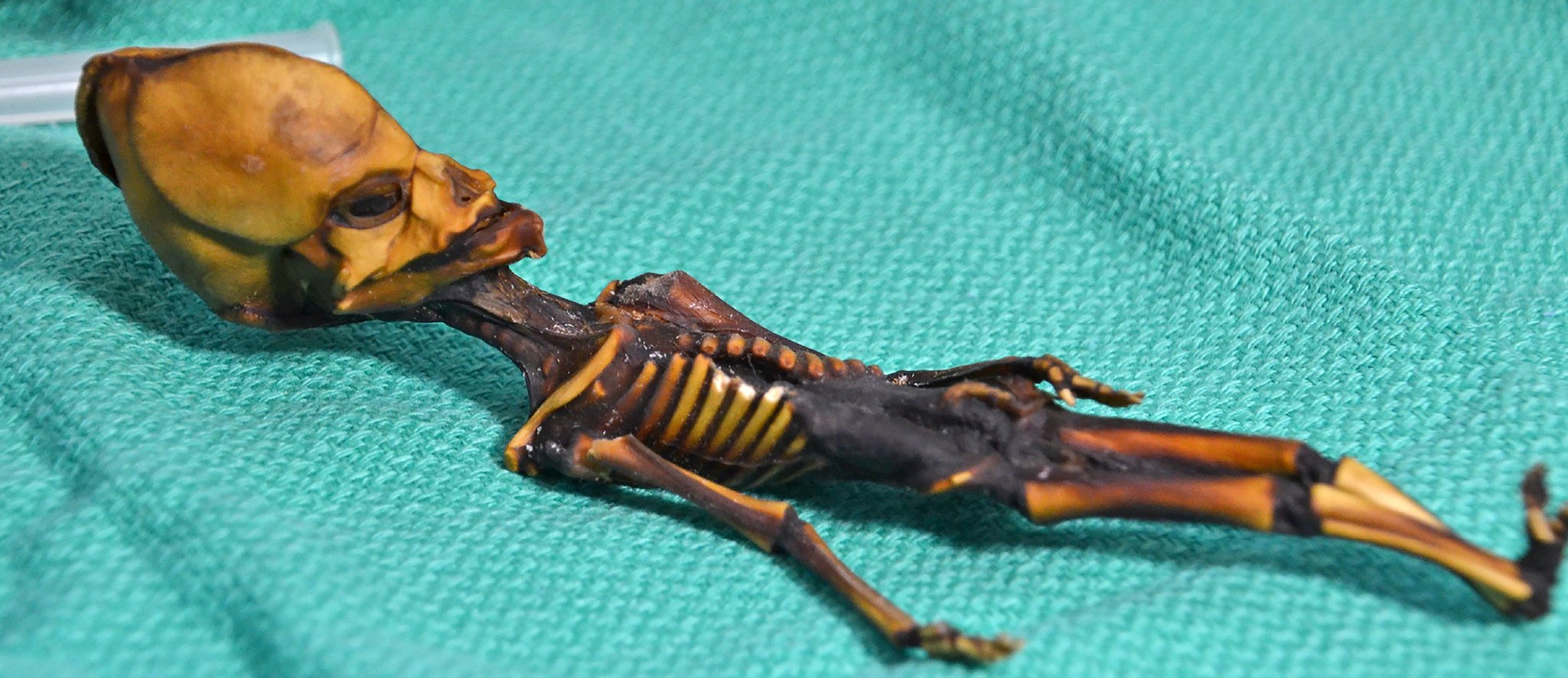The tiny misshapen skeleton rumored to be that of an otherworldly visitor is only human after all

We want to believe: “Ata,” a mummy found in Chile’s Atacama region, inspired theories and rumors.
Credit: Bhattacharya, S. et al., 2018
It started the way some of the best mysteries do: a strange discovery in a remote and otherworldly place; rumors that spread through obscure corners of the world, occasionally flickering into view; and the resolution of the mystery, revealing that the truth is as curious as the rumors. (Well, almost.)
This is the story of Ata. In 2003, high in the Atacama region of northern Chile, an amateur collector was exploring a ghost town (perhaps literally, if the many reported sightings of departed residents are to be believed) and, the story goes, found a leather pouch next to an abandoned church. The pouch contained an object wrapped in white cloth and tied with a violet ribbon. The white cloth swaddled a tiny body, just six inches long, with an elongated, pointed head; misshapen body; and large, ovoid eye sockets. It had 10 pairs of ribs instead of the standard-issue 12. It looked like an alien.
The “is it an alien?” issue was colored by the context in which she (for we know she is a “she”) was found: the Atacama – for which Ata was named – plays an important role in space research. This high, dry, lonely, barren landscape serves as a stand-in for Mars as NASA test-drives its rovers; is peered at by biologists, chemists, and others studying life in extreme environments so we’ll know what to look for on other planets; and its cloudless, pollution-free sky makes it the ideal site for telescopes. (Weizmann astrophysicists are among those using the Atacama’s telescopes; e.g., the recent observation of two neutron stars colliding took place at the Paranal Observatory.)
Being “discovered” was just the beginning of Ata’s journey; next she was sold on the archaeological black market to a collector in Barcelona. By this point, the whispers about an alien mummy were at a low roar – and, in fact, the collector was a “ufologist” (someone who studies UFOs, as any fellow “X Files” aficionado knows). It was at a ufologist conference that the collector mentioned Ata to fellow-believer Stephen Greer, who happened to also be a retired ER doctor. Greer was able to take a tiny sample of DNA from Ata, Dr. Garry Nolan at Stanford University offered to test the sample – and the mystery was solved.
In a recently published paper, Nolan and a talented team of scientists reported that they’d deciphered Ata’s entire genome, and that the girl was unequivocally human. Some of her bones, such as her hands, appeared to be those of a six- to eight-year-old child, but even if she were born alive, Ata likely died shortly afterward.
The discovery of mutations that may have aged Ata’s bones could, in the future, help patients with skeletal problems, according to Nolan. “Understanding the process might allow us to develop therapies or drugs that drive bone development for people in, say, catastrophic car crashes,” he said in The Guardian.
As The New York Times reported, some of Ata’s many mutations “might be responsible for the skeleton’s bizarre form, causing a hereditary disorder never before documented in humans.”
And while many of her mutations did match known bone disorders, as discussed in The Washington Post, they also included “two variants new to the scientific literature that code for an abundant structural protein called collagen.”
Interestingly, Weizmann’s Valery Krizhanovsky, who studies aging – or senescence – in cells, has shown a relationship between collagen production, aging, and disease. For example, he found that cleaning out the buildup of senescent cells can improve tissue health, and that doing such cleanup in the liver reduced collagen production and other factors associated with increased risk of liver cancer.
It is a challenge for scientists to find unique individuals such as Ata, who – beyond her legendary looks – can teach us so much about our bodies in health and disease. And, hopefully soon, this tiny stranger can finish her unasked-for journey – and rest in peace in the Mars-like desert that was her home.


